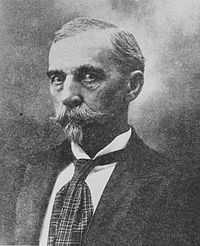John Rankin Rogers
| John R. Rogers | |
|---|---|
 | |
| 3rd Governor of Washington | |
| In office January 11, 1897 – December 26, 1901 | |
| Preceded by | John H. McGraw |
| Succeeded by | Henry McBride |
| Personal details | |
| Born | September 4, 1838 Brunswick, Maine[1] |
| Died | December 26, 1901 (aged 63) Washington |
| Political party | Populist / Democrat |
| Spouse(s) | Sarah L. Greene (1840-1909) |
| Profession | druggist, educator, farmer |
John Rankin Rogers (1838 - 1901) was the third Governor of the state of Washington. Elected as a member of the People's Party before switching his affiliation to the Democratic Party, Rogers was elected to two consecutive terms in 1896 and 1900, but died before completing his fifth year in office.
Biography
Early years
John R. Rogers was born September 4, 1838 in Brunswick, Maine.
Rogers went to Boston as a youth and apprenticed as a druggist, then moved south to Mississippi in 1856 to manage a drug store for four years in Jackson. He moved north to Illinois in 1860, where he farmed and worked was a school teacher and druggist. He married Sarah Greene in 1861 and together they had five children.[2]
In 1876 the family relocated to Kansas to farm and Rogers was later an editor of the Kansas Commoner for several years in Wichita, and was an organizer within the Farmers' Alliance. Rogers was an advocate for The Single Tax Movement associated with Henry George.[3]
Rogers moved to Washington in 1890 and settled in Puyallup, where he operated a drug store.
Political career
Rogers was elected to the Washington House of Representatives in 1895 as a Populist,[4] and governor the following year. As governor he supported the "Barefoot Schoolboy Act" which he had first sponsored while in the state legislature. The Act provided a mechanism of state funding to equalize support for free public education between counties which had a large tax base and those without.
John R. Rogers authored many books, pamphlets and articles[2] that followed a Populist and Arcadian Agrarian spirit. Growing up in New England when Jeffersonian ideals were talked about frequently was a strong influence on his political future.
Death and legacy
Rogers served as Governor from January 11, 1897 until his death from lobar pneumonia on December 26, 1901 at age 63.[2] Rogers is buried in the Woodbine Cemetery in Puyallup.[1]

Two high schools in the state are named for Rogers, on either side of the Cascade Mountains. John R. Rogers High School in Spokane in eastern Washington opened in 1932 and Governor John R. Rogers High School in Puyallup opened in 1968.
Rogers Field, the football and track stadium at Washington State University in Pullman, was named for him in 1902. A fire, a suspected arson, significantly damaged the wooden stadium in April 1970.[5] The stadium was reconstructed in 1972 and its name changed to Martin Stadium, after Clarence D. Martin, the eleventh governor of Washington (ironically, a graduate of the University of Washington). The present-day Rogers Field at WSU refers to the practice and intramural fields directly west of the stadium.
Footnotes
- ↑ 1.0 1.1 John Rankin Rogers at Find a Grave
- ↑ 2.0 2.1 2.2 John Rankin Rogers Papers, 1814-1926," Washington State University, Pullman, WA.
- ↑ Robert Clancy, "The Story of the Georgist Movement," www.cooperativeindividualism.org/
- ↑ OurCampaigns.com-John Rankin Rogers
- ↑ Spokesman-Review - Fast blaze ruins Pullman stadium - 1970-04-06 - p.1
Further reading
- David B. Griffiths, "Far-Western Populist Thought: A Comparative Study of John R. Rogers and Davis H. Waite," Pacific Northwest Quarterly, vol. 60, no. 4 (Oct. 1969), pp. 183-192. In JSTOR.
- R. Douglas Hurt, "John R. Rogers: The Union Labor Party, Georgism, and Agrarian Reform." Journal of the West, vol. 16 (January 1977), pp. 10-15.
- Edmond S. Meany, Governors of Washington: Territorial and State. Seattle: University of Washington, 1915.
External links
| Wikimedia Commons has media related to John Rankin Rogers. |
- Examination of the Barefoot Schoolboy Act at Washington Secretary of State website
| Political offices | ||
|---|---|---|
| Preceded by John H. McGraw |
Governor of Washington 1897–1901 |
Succeeded by Henry McBride |
| ||||||||||
| |||||||||||||||||
|
